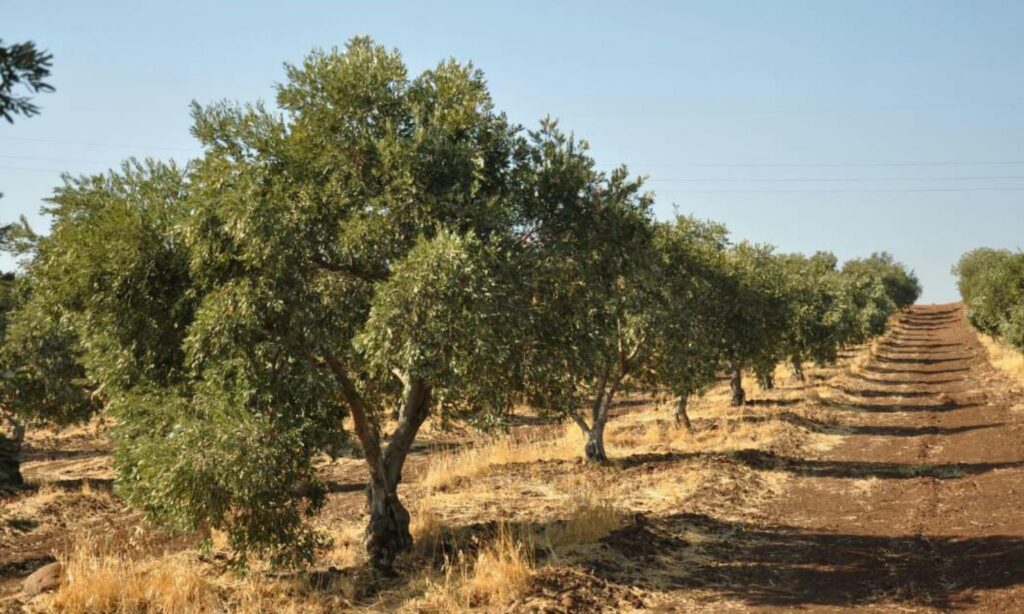Farmers in Homs governorate, central Syria, have been forced to harvest their olive crop earlier this season to avoid theft, contrary to the usual practice every year, where harvesting begins on October 10.
This season is eagerly awaited by farmers, a wide range of laborers, and oil mill owners, in a governorate planted with 98 thousand hectares of olives (of which 12 thousand hectares are irrigated and 86 thousand hectares rain-fed), with a total of about 15.5 million trees.
Early olive harvesting has begun
A farmer in the countryside of Homs stated to Enab Baladi that many farmers had to hasten the harvesting process due to fears of theft that occur every year, considering it a natural result of rising prices and the state of insecurity in the area.
He mentioned that residents of the al-Saan al-Aswad village caught three young men attempting to steal olives and handed them over to the police on October 8.
Farmers rely on their families if the land is small and on labor workers if the areas are large. The harvesting wages this year range between 10,000 and 15,000 Syrian pounds (with every 1 US dollar equivalent to 15,000 Syrian pounds) for each kilogram of olives.
The farmer is currently preparing to start harvesting olives on his land, as he owns 1,400 trees, expecting a plentiful yield this year.
After finishing the olive harvest, the farmer hires a truck to take the olives to the oil mill, and the costs depend on the distance traveled and waiting time at the mill, which can reach up to 500,000 Syrian pounds. At the mill, the farmer supplies empty containers, which can be either plastic or tin metal, holding up to 16 kilograms of oil.
Every 4 to 7 kilograms of olives produce one kilogram of oil, and this may vary slightly depending on the quality of the olives, their type, and the care given to them.
The executive offices in the governorates have set the fees for olive oil extraction between 500 and 750 Syrian pounds for each kilogram of olives.
There are 53 olive mills in Homs governorate, spread across the province, competing to attract farmers either by reducing extraction fees or by covering transportation costs.
Approximately 82,000 tons of olives in Homs
The production of olives this year in Homs governorate is estimated at about 82,755 tons, according to what the director of the Olive Office in the Ministry of Agriculture, Engineer Abeer Jawhar, announced. The total production in Syria is estimated at 740,280 tons.
The price of one kilogram of olive oil has reached 80,000 Syrian pounds, and it is expected that prices will decrease during the harvest season due to the abundant quantities of production. Prices may rise if the export gate is opened, as the global price for one ton of olive oil is 8,703 US dollars (about 129 million Syrian pounds).
On October 9, the Ministry of Economy and Foreign Trade in the Syrian regime’s government issued executive instructions allowing licensed companies and factories to filter and package olive oil to export 10,000 tons of the product.
Care in phases
Olive trees require care throughout the year, as stated by Anas Haddad, an olive farm owner in the eastern countryside of Homs.
After the harvest, olives first need to be properly pruned to allow sunlight to reach all tree branches. They also require fertilization, preferably relying mainly on organic fertilizer, but some nitrogen fertilizer and superphosphate can be added, according to the farmer.
He added that the land must be plowed several times a year to remove weeds, and pest control must be managed using chemical pesticides.
Haddad typically sprays his olive trees three times a year, guided by an expert in pest and fungal disease control, as well as to stabilize the yield and increase production.
Sometimes the farmer adds treatments during irrigation to eliminate soil worms that may be detrimental to the trees.
He usually irrigates his trees once a month throughout the year, focusing on irrigation in December during the rain season and in March and May so that the trees can produce new shoots and branches in the following year.
Olive cultivation in Homs began in the mid-1970s when some farmers brought seedlings from the city of Afrin.
Its cultivation expanded later, especially after 2005, and the number of olive trees reached 15 million and 600 thousand trees, of which 14 million are rain-fed, according to estimates by the head of the fruit trees department in the Homs Agricultural Directorate, Engineer Najy Saad.











